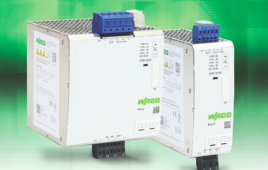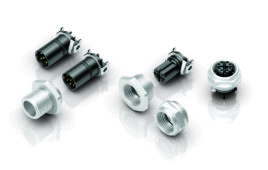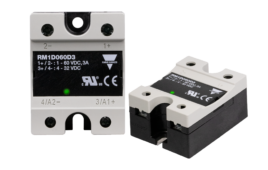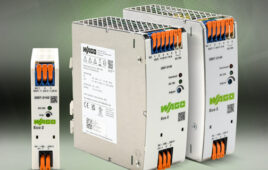by Miles Budimir, Senior Editor
Technology advances in many areas are contributing to the ongoing smart grid build out.
Consider this: A report this summer in Business Week stated that power outages are up 285% since 1984 in the U.S. and that the U.S. ranks last among the top nine Western industrialized nations in average length of outages. All of this costs businesses around $150 billion each year according to data from the Energy Information Administration.
The numbers are sobering, both in terms of the problems with the current grid as well as the daunting challenges ahead for a system that is getting older by the day. The vast and complex system will require significant investment to bring it up to the levels of sophistication and reliability expected in the 21st century. Some estimates put the cost at hundreds of billions of dollars.

A smart grid ensures that renewable energy sources can be better integrated into the grid thanks to a two-way flow of energy (orange line) and a bidirectional flow of communication data (blue green line). Whereas the generation of power in conventional power supply networks depends on consumption levels, a smart grid also is able to control consumption – depending on the availability of electrical power in the grid. Illustration courtesy of Siemens
Whether this is due to aging infrastructure or a “dumb” grid may not matter in the end. What does matter and what now appears indisputable is that the U.S. electrical grid could use an upgrade. With new sources of electricity coming on board, most notably from wind and solar, the time appears right to rethink the entire grid and update it for the 21st century.
The idea of the smart grid is certainly not new. Examples of automatic metering date back to the 1980s, from which evolved the earliest smart meters. If anything, the smart grid has been more of a gradual evolution over time, based on current demands as well as the cutting edge technology of the time. So far the efforts have been piecemeal at best, with a few municipalities and utilities upgrading pieces of their infrastructure here and there.
Still, there is a lot of activity surrounding the smart grid. For instance, there are developments from the generation side as wind and solar sources come on board and also at the metering side with smart meters. The other part of the equation is the electricity consuming devices we already use on a daily basis, which are already “smart” and getting more intelligent with each new generation.
The smart grid is also a natural tie-in with the emerging Internet of Things (IoT). This is because both smart grid and IoT technologies represent a convergence of several technology areas including sensors, communication, and processing and control, as well as analytics and big data. And similar to the IoT, the grid is itself becoming an information technology because all of the elements are already there including networking, security, and electronics. It’s now just a matter of tying all of the pieces together.
One thing is clear, unified plan or not, a host of manufacturers continue to develop and market products for both the consumer end of the smart grid as well as the utility end. Here’s a brief overview of what’s new.
Smart Grid Design Tools
Companies like Texas Instruments (TI) have a suite of design tools aimed specifically at smart grid applications. These tools include evaluation boards for designing smart meters as well as complete e-meter systems on a chip, for both single-phase applications (such as for residential purposes) and three-phase applications for industrial and commercial uses.
A good example is the company’s new power line communication (PLC) modems to support all three major communication standards (G3, PRIME and IEEE-1901.2) across multiple spectrum bands including both CENELEC and ARIB frequency bands. It allows developers to create PLC products for multiple countries and regions through a single platform.
The new optimized TMDSPLCKITV4 kits provide developers with a smaller low-cost design to evaluate any narrowband orthogonal frequency-division multiplexing (OFDM) PLC technology standard for use in a variety of industrial systems such as smart grid advanced metering infrastructure (AMI), solar energy installations, and building and factory automation systems.
Microcontrollers are a central part of smart grid applications. For instance, the company’s MSP430FR69x FRAM microcontrollers (MCUs) can be used in smart grid applications. The integrated ESI module, differential ADC and LCD controller suit smart flow metering designs for water, gas and heat. Adding TI’s complementary SimpleLink Sub-1 GHz CC1120 transceiver, SimpleLink Wi-Fi CC3100 wireless network processor or Wireless M-Bus connectivity systems can easily connect a new MSP430FR69x-based flow meter design to the grid. Developers can also include TI’s TPS61220 boost converter to optimize battery powered systems. TI’s new FlowESI GUI eases sensor setup in software and EnergyTrace++ technology enables developers to debug power consumption at a function and peripheral level.
Distribution Management System for Smart Grids
On the utility end, earlier this year Siemens launched a distribution management system for smart grids, the first of its kind in the U.S. The Spectrum Power ADMS (Advanced Distribution Management System) combines SCADA (Supervisory Control and Data Acquisition), outage management, and fault and network analysis functions for the first time on a software platform within a consolidated user environment, the first of its kind in North America. The aim is to simplify workflows and facilitate efficient data management. The system also allows network operators to not only control and monitor their distribution network more reliably, but also track and restore outages and carry out maintenance and repair work more efficiently.
By suggesting remedial actions and restoration processes, the system assists grid operators in isolating and restoring the affected network sections as quickly as possible after a fault. The system also leverages the intelligent use of smart meter data for outage prediction, fault detection and clearance, and for managing distributed energy sources.
The system can make use of services and data from other IT systems, such as network data from geographic information systems or load profiles from meter data management systems. In the same way, other IT systems can access services and data in the distribution network management system, like information for customer information systems about downtime in case of a malfunction, or work orders or switching jobs for the workforce management system. Spectrum Power ADMS can be integrated in the user’s IT environment, promoting business process optimization and work process automation.
The system provides the grid operator with the right tools to comply with the requirements of international reliability standards such as NERC CIP (North American Electric Reliability Corporation – Critical Infrastructure Protection) or those of the US federal agency NIST (National Institute of Standards and Technology). Interoperability standards such as IEC 61970 (CIM, Common Information Model) and IEC 61968 (system interfaces for distribution networks) have also been taken into account in order to facilitate the IT integration of the system in an existing infrastructure.
Prosumer Microgrid Solutions
Schneider Electric also offers a broad range of tools for smart grid development. Dubbed Prosumer (for proactive consumer) they address the smart grid from the consumer side rather than the utility/supply side. This stretches across many different fronts including residential, commercial and industrial, and large sites such as campuses and multiple building facilities. One example is a microgrid offering for commercial and industrial buildings. The solution consists of three parts; the demand-side operation, smart gateways and load controllers, and an electrical energy storage system.
The Prosumer Microgrid Solution tracks energy relevant inputs and predicts the load profile for each building in a multi-building complex. It then minimizes energy costs using demand management techniques such as load shifting, peak shaving, or participation in demand response. The system can also calculate and offer energy flexibility to the grid, arbitrate between opportunities, and coordinate load curtailment or other actions on request.
It also helps to increase energy independence by taking full advantage of onsite renewable energy production from solar panels or wind power and building one’s own microgrid. The energy storage system acts as a backup power supply, automatically keeping critical equipment running during a blackout. When grid power returns, the system will immediately switch back to charging from solar panels. The Prosumer Microgrid Solution integrates with existing control systems, using intelligent energy management to make generation sources and loads smarter.
Smart Grids in Action
In terms of applications in the field, recently ABB announced that it will install its PowerStore, an integrated commercial flywheel technology, to integrate with a battery system on Kodiak Island in Alaska. The installation will help enable the integration of more renewable energy from an expanded wind farm to its microgrid and also to address stability challenges that will arise from a crane upgrade being undertaken to enhance its port operations. The project is being undertaken on behalf of Kodiak Electric Association (KEA), an electric cooperative owned by residents of the island. KEA operates a microgrid that generates virtually all of its 28 megawatts (MW) of electricity capacity from hydropower and wind.

TI’s new power line communication (PLC) modems for smart grid development supports a number of major communication standards.
The City of Kodiak in conjunction with Horizon Lines decided to upgrade its existing crane to an electrically driven crane instead of a diesel driven one and expand its capabilities. The installation of the larger crane is expected to generate power fluctuations that can be particularly destabilizing for an isolated grid like the one on Kodiak Island. PowerStore’s dynamic response to transient events such as those expected from the new crane as well as the ability to carry out infinite charge and discharge cycles without degrading life expectancy make it an ideal fit.
ABB’s solution incorporates two 1 MW PowerStore grid stabilization generators. They’re based on a fast-acting, spinning flywheel with ABB inverters to store short term energy to absorb and/or inject both real and reactive power onto the microgrid. PowerStore can switch from a full-power charge to a full-power discharge in less than 5 milliseconds. Besides providing voltage and frequency support for the new crane, the PowerStore units will extend the life of the two 1.5 MW battery systems and help to manage the intermittencies from the island’s 9 MW wind farm.

Commercial flywheel technology from ABB is being installed in a smart grid application on Alaska’s Kodiak Island.
“Remote locations like islands may be rich in renewable energy sources, but the intermittent nature makes their integration into the power grid a challenge,” said Claudio Facchin, head of ABB’s Power Systems business. “ABB’s microgrid solution in this case includes grid stabilization technology that enables high penetration of renewable power generation, and distributed control systems that provide intelligent power management and efficient hybrid power plant operation.”
PowerStore is one of two core technologies comprising ABB’s Microgrid Plus, enabling penetration of renewable energies up to 100% and facilitating their integration into a microgrid with a high level of grid stability. The second core technology is the MGC600 decentralized microgrid control system, which consists of control modules distributed across the microgrid area. These modules communicate with each other on a peer-to-peer basis, providing a high level of flexibility and redundancy.
“The grid” refers to the electric grid, the network of transmission lines, substations, transformers and other equipment that provides electric power to homes and businesses. The current electric grid was built in the 1890s and improved upon as technology advanced. Today, it consists of more than 9,200 electric generating units with more than 1 million megawatts of generating capacity connected to more than 300,000 miles of transmission lines.
The grid is being stretched to its capacity, especially with the rise in renewable energy sources and the fact that there are many more points of origin for power sources. There is also a need to integrate the digital and computerized equipment and technology dependent on it and to automate and manage the increasing complexity.
The “smart” part of the smart grid refers to the digital technology that allows for two-way communication between the utility and its customers, and the sensing along the transmission lines is what makes the grid smart. Like the Internet, the Smart Grid consists of controls, computers, automation, and new technologies and equipment working together.
The smart grid represents an opportunity to move the energy industry into a new era of reliability, availability, and efficiency. In addition, the smart grid is a way to address an aging energy infrastructure that needs to be upgraded. Benefits include:
• More efficient transmission of electricity
• Quicker restoration of electricity after power disturbances
• Reduced operations and management costs for utilities, and ultimately lower power costs for consumers
• Reduced peak demand, which will also help lower electricity rates
• Increased integration of large-scale renewable energy systems
• Better integration of customer-owner power generation systems, including renewable energy systems
• Improved security
Today, an electricity disruption such as a blackout can have a domino effect. A smarter grid will add resiliency to the electric power system and make it better prepared to address severe storms and other emergencies. Because of its two-way interactive capacity, the smart grid will allow for automatic rerouting when equipment fails or outages occur, which will help minimize the effects of an outage.

The diagram illustrates the many communication nodes on a typical smart grid, from generation and transmission to customers.
When a power outage occurs, smart grid technologies will detect and isolate the outages, containing them before they become large-scale blackouts. The new technologies will also help ensure that electricity recovery resumes quickly and strategically after an emergency—routing electricity to emergency services first, for example. In addition, the smart grid will take greater advantage of customer-owned power generators to produce power when it’s not available from utilities. (Information and image obtained from www.smartgrid.gov.)
Texas Instruments
www.ti.com
Siemens
www.siemens.com
Schneider Electric
www2.schneider-electric.com
ABB
http://new.abb.com/smartgrids
Filed Under: ELECTRONICS • ELECTRICAL





Tell Us What You Think!